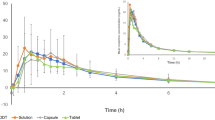Abstract
Objective: To compare the efficacy, safety and pharmacokinetics of a newly developed controlled- release suppository (MSR) with MS Contin tablets (MSC) in cancer patients with pain.
Methods: In a double-blind, randomised, two-way cross-over trial, 25 patients with cancer pain were selected with a morphine (M) demand of 30 mg every 12 h. Patients were divided into two groups. Group 1 received active MSC (30 mg) and placebo MSR, followed by placebo MSC and active MSR (30 mg) each for a period of 5 days. Group 2 started with active MSR and placebo MSC, followed by active MSC and placebo MSR, each for a period of 5 days. Blood for determination of plasma concentration of morphine (M) and its 3- and 6-glucuronides (M3G, M6G) was collected, and area under the plasma concentration–time curve (AUC)0–12 h, peak plasma concentration (Cmax), time to reach Cmax (tmax), and C0 and C12 of M, M6G and M3G were determined on day 5 and day 10. Intensity of pain experienced by each patient was assessed every 2 h on a 0–10 scale, while side effects and rescue medication were recorded.
Results: Twenty patients (ten patients in each group) completed the study. A pronounced inter-patient variability in plasma concentrations of M, M3G and M6G was observed after administration of both forms. Apart from the C0 and C12, no significant differences in AUC0–12 h, tmax and Cmax of morphine between the rectal and oral route of administration were found. In the case of the metabolites, it was found that AUC0–12 h and Cmax of M6G, and AUC0–12 h, Cmax, C0 and C12 of M3G after rectal administration were significantly lower than after oral administration. However, apart from the tmax of M6G, none of the pharmacokinetic parameters of M, M6G or M3G met the criteria for bioequivalence. There were no significant (P=0.44) differences in pain intensity score between the oral and rectal forms within the two groups, regardless of the treatment sequence. No treatment differences in nausea, sedation or the demand on escape medication (acetaminophen tablets) between the rectal and oral forms were observed.
Conclusion: The newly developed controlled-release M suppository is safe and effective and may be a useful alternative for oral morphine administration in patients with cancer pain.
Similar content being viewed by others
Author information
Authors and Affiliations
Additional information
Received: 3 September 1999 / Accepted: 15 March 2000
Rights and permissions
About this article
Cite this article
Moolenaar, F., Meijler, W., Frijlink, H. et al. Clinical efficacy, safety and pharmacokinetics of a newly developed controlled release morphine sulphate suppository in patients with cancer pain. E J Clin Pharmacol 56, 219–223 (2000). https://doi.org/10.1007/s002280000133
Issue Date:
DOI: https://doi.org/10.1007/s002280000133




